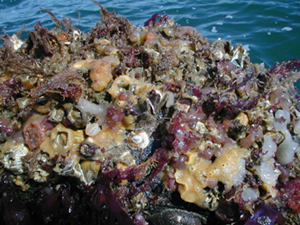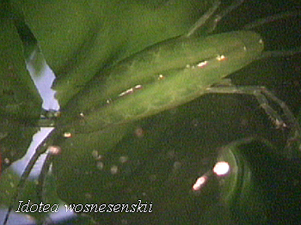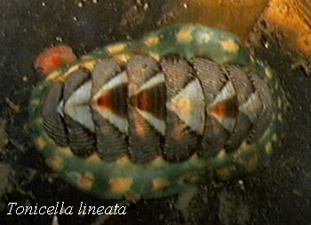Locomotion
on the FHL floating dock habitat
What's riding (creeping,
crawling) on all those tires?
 Virtually
every square inch of submerged rubber on the FHL floating dock tires has
been colonized by an incredible variety of organisms, the majority of which
are sessileśthat is, fixed in place. The most common kinds of sessile animals
living on the tires and taking up most of the primary surface area, are
sponges, tunicates, bryozoans and barnacles. Other immobile tire inhabitants
include hydrozoans, sea anemones and several different kinds of tube-dwelling
polychaete worms. Although these organisms do not have the ability to relocate
themselves on the tires once they've settled, they are nonetheless in constant
battles with one another for the additional tire space needed for growth.
In our study of this floating community, we found abundant evidence
of organisms overgrowing one another in these desperate competitions for
space.
Virtually
every square inch of submerged rubber on the FHL floating dock tires has
been colonized by an incredible variety of organisms, the majority of which
are sessileśthat is, fixed in place. The most common kinds of sessile animals
living on the tires and taking up most of the primary surface area, are
sponges, tunicates, bryozoans and barnacles. Other immobile tire inhabitants
include hydrozoans, sea anemones and several different kinds of tube-dwelling
polychaete worms. Although these organisms do not have the ability to relocate
themselves on the tires once they've settled, they are nonetheless in constant
battles with one another for the additional tire space needed for growth.
In our study of this floating community, we found abundant evidence
of organisms overgrowing one another in these desperate competitions for
space.
Colonization of tire
surfaces by sessile organisms allows these floating habitats to support
an additional, less conspicuous, contingent of creatures that have the
distinct advantage of mobility. Locomotor capacity enables food to be searched
for rather than waited for; predators can be escaped from or hidden from
rather than succumbed to; environments that become unfavorable for any
number of reasons, physical or biological, can be left behind for the promise
of a new home tireśmaybe one that's seen fewer than 60,000 miles.
On a floating dock
community in particular, mobility allows animals to make the most of the
density and variety of sessile tire inhabitants, which provide them with
an abundance of food and a topographically complex little environment with
lots of hiding spots. Mobile creatures that live on the tires also have
the option, if they're fast enough, to abandon ship whenever their home
is heaved up out of the water and onto the dock by eager FHL graduate students.
 Of
course, some kinds of locomotion are impractical or impossible in the floating
dock habitat. Animals that require soft substrates in which to burrow (e.g.
many of the worms found in False
Bay) have no way to make a living, locomotory or otherwise, on the
tires and are thus not present. Large mobile animals are, in general, rarely
found on the tires, partly because they sometimes escape before the tire
is brought up out of the water but also partly because of both the limited
extent and vertical orientation of most of the tire surface area. Large
crustaceans, for instance, would have to suspend themselves from those
surfaces on a nearly continuous basis. One of the largest mobile organisms
to come up during our surveys was a crab called Hapalogaster mertensii,whose
carapace measured only about 5 cm across.
Of
course, some kinds of locomotion are impractical or impossible in the floating
dock habitat. Animals that require soft substrates in which to burrow (e.g.
many of the worms found in False
Bay) have no way to make a living, locomotory or otherwise, on the
tires and are thus not present. Large mobile animals are, in general, rarely
found on the tires, partly because they sometimes escape before the tire
is brought up out of the water but also partly because of both the limited
extent and vertical orientation of most of the tire surface area. Large
crustaceans, for instance, would have to suspend themselves from those
surfaces on a nearly continuous basis. One of the largest mobile organisms
to come up during our surveys was a crab called Hapalogaster mertensii,whose
carapace measured only about 5 cm across.
 |
Very small crustaceans
and other kinds of arthropods thrive in the tire habitat. Their agility
and small body sizes are ideally suited to life on a suspended (i.e. floating)
and topographically intricate surface. The isopod Idotea wosnesenskii,about
2 cm long, makes its way very quickly over the alga Ulva fenestrata
but manages to stay firmly attached all the while. Many tiny amphipods
(~1 mm) inhabit the minute bryozoan forests that blanket the tires. Their
activity, barely visible to the naked eye, turns the bryozoan colonies
into veritable hubs of motion when viewed under a microscope. |
|
Many tire inhabitants
move more slowly and less frequently than the arthropods. The chitons (Tonecella
lineata) and limpets that are common on the outside tires seem to prefer
rubber surfaces that are nealy free of encrusters, moving about on them
over secreted mucous films. Although these species are mobile, both of
them can attach themselves to their steel-belted substrate with such tenacity
that only a prying tool can remove them. This chiton is about 5 cm long. |
 |
 |
The nudibrachs also
move relatively slowly through their habitats, as sea slugs are wont to
do. Phidiana crassicornis, about 1 cm long, is often seen creeping
lethargically over tire sponge and tunicate mats and it is much more easily
collected than chitons or limpets. The nudibranch's ability to traverse
roughened landscapes allows it to seek out food on all parts of the tire. |
|
The various methods
of locomotion used by animals inhabiting this floating dock community reflect
both its diversity and its obvious limitations. The density and variety
of sessile organisms found on the tires provides both food and shelter
to the mobile animals that can navigate it at will, such as small nudibranchs,
crabs and other crustaceans. Most large animals are excluded; others are
restricted to areas of the tire that have yet to be recruited by the dominant
sessile species. |
 |
For more information on the locomotion
of different marine invertebrates in their natural habitats around San
Juan Island, visit the following web pages:
Argyle
Creek
Cattle Point
False Bay
Plankton
Back
 Virtually
every square inch of submerged rubber on the FHL floating dock tires has
been colonized by an incredible variety of organisms, the majority of which
are sessileśthat is, fixed in place. The most common kinds of sessile animals
living on the tires and taking up most of the primary surface area, are
sponges, tunicates, bryozoans and barnacles. Other immobile tire inhabitants
include hydrozoans, sea anemones and several different kinds of tube-dwelling
polychaete worms. Although these organisms do not have the ability to relocate
themselves on the tires once they've settled, they are nonetheless in constant
battles with one another for the additional tire space needed for growth.
In our study of this floating community, we found abundant evidence
of organisms overgrowing one another in these desperate competitions for
space.
Virtually
every square inch of submerged rubber on the FHL floating dock tires has
been colonized by an incredible variety of organisms, the majority of which
are sessileśthat is, fixed in place. The most common kinds of sessile animals
living on the tires and taking up most of the primary surface area, are
sponges, tunicates, bryozoans and barnacles. Other immobile tire inhabitants
include hydrozoans, sea anemones and several different kinds of tube-dwelling
polychaete worms. Although these organisms do not have the ability to relocate
themselves on the tires once they've settled, they are nonetheless in constant
battles with one another for the additional tire space needed for growth.
In our study of this floating community, we found abundant evidence
of organisms overgrowing one another in these desperate competitions for
space.
 Of
course, some kinds of locomotion are impractical or impossible in the floating
dock habitat. Animals that require soft substrates in which to burrow (e.g.
many of the worms found in
Of
course, some kinds of locomotion are impractical or impossible in the floating
dock habitat. Animals that require soft substrates in which to burrow (e.g.
many of the worms found in 


